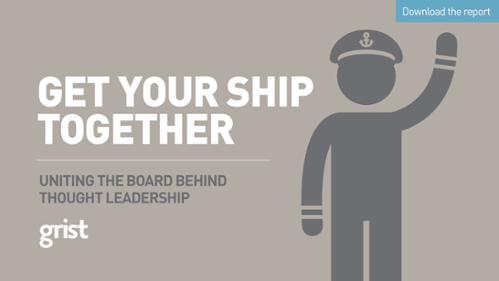Thought leadership development requires a delicate balancing act: harnessing the right stakeholders to input at the right time with the right insights, especially if you want your thought leadership project to truly move the needle.
And when those stakeholders are often very senior people in the business - leaders with important day jobs and fee-earning commitments - things become very tricky indeed. Why would partners join your marcomms meeting when they have wall-to-wall client meetings all week?Yet, to ensure your thought leadership is well planned and well executed, the involvement of those senior stakeholders is non-negotiable. How can you do it?
Who should be involved in your thought leadership - and when?
At the risk of seeming glib, everyone needs to be involved in your thought leadership, ideally - but in the right way and at the right time. Only by winning the hearts and minds of partners can you ensure your thought leadership project hits the mark – the X that marks the spot of original, authoritative and insightful ideas to sway the industry conversation.
You’ll need to fill a few roles:
- A project sponsor or champion, preferably in the senior leadership team, to lead the steering group and encourage the whole firm to back the project.
- A steering group of key stakeholders to add direction, validate the plan, and bring in essential client insights - keep it small, though; too many cooks will definitely spoil the thought leadership broth.
- A wider group of stakeholders to help socialise the project and promote the campaign. They don’t need to be involved in the planning and validation, but should be kept informed of the project’s status. It’s a good idea to involve sales, marketing and PR here as they’ll be the ones spreading the word.
Don’t forget the rest of the company, too - you’ll need them when it comes to sharing findings and campaign assets when the time comes, but they don’t need to be involved during the pre-launch phases.
Essential roles over the three stages of thought leadership
Planning: Internal stakeholder support is essential
Stakeholders needed:
- Project sponsor/champion
- Steering group
- Marcomms leaders
- Small number of individuals to act as a sounding board
Embarking on a thought leadership project is a big decision, but thought leadership has moved on from the days of pure brand-building. These days thought leadership is an essential part of the sales funnel, a way for a company to show it deeply understands its business, the needs of its clients and the broader marketplace in which it operates. That’s why internal stakeholder support is so essential.
To kick off your project, develop a plan and hypotheses for your research to prove, working with a small steering group who have a clear view on commercial objectives. This planning can be done in a single meeting; it doesn’t have to be, nor should it be, a drawn-out process.
Both before and after this planning meeting, conduct a few interviews to test the idea with a diverse group of internal and external people. Do this in separate interviews and then aggregate the feedback to inform your planning; you want to ensure you remain in the driving seat and don’t lose control to committee-think.
And once the plan is ready, test and socialise it with a wider group before pressing Go on the formal research, just to be sure you’re in the right ballpark.
Insight: Views needed on how the findings tie to the proposition
Stakeholders needed:
- Project sponsor/champion
- Steering group
This is where you hand the reins over to the research experts, who’ll do the fieldwork, data analysis and interpretation. That said, once the findings come in you’ll need the steering group to reconvene. This is another critical stage for the steering group to share their insights into what the findings mean for clients and how the research ties in with the company’s proposition. Again, this can be explored at a single workshop led by your researchers.
With findings in hand and hypotheses proved (or otherwise), it’s time to get the key messaging agreed. You’ll then want specific input and quotes from individual experts, both internal and external, to add qualitative insights to the quantitative data - our own research has found that 39% of the C-suite respond to qualitative research (vs 34% quantitative); although 27% want both quantitative and qualitative research .
Again, manage this input as separate, short interviews to solicit specific feedback - don’t open it for debate. You just want the views to add to your final report, not arguments about whether this was the right question to ask.
“The more opinions you source, the longer things will take,” Layisha Laypang of Efficio told us. “Identify key milestones in the project and communicate these with the wider business, that way you’re sharing information without creating undue delays.”
Activation: Time for the whole company to jump in
Stakeholders needed:
- Project sponsor/champion
- Steering group
- Sales and marketing
- Employees
- Clients and partner organisations
You’re almost there. If you’ve effectively sold the project during its development, this is now the time to explode the research across the widest possible network, both internal and external. Your new stakeholders include sales - to get it in front of clients and prospects - and marketing, who’ll be able to use the findings in campaigns for a long time to come. Plus PR, who can sell in the results to media and trade press and lift the company’s brand awareness.
Make sure you educate and encourage staff and give them the confidence and tools to use the research themselves. Consider an internal toolkit for the activation phase: events, a SlideShare, crib sheets, benchmarking tools, easy-to-use social assets, and so on.
You CAN get value from senior stakeholders with minimal impact on day jobs
Often the reasons senior stakeholders are reluctant to get involved in a thought leadership project is the imagined pull on their time. These are busy people, after all, and fee-paying work will always come first.
The truth is that this kind of project does take time for those leading it, but for the senior stakeholders giving their insights and adding validation to progress it really doesn’t need a great deal of time. In exchange for just a few short meetings - the project kick-off; discussing survey questions; exploring the results; signing-off on the final reports - the senior stakeholder can lay claim to adding credence to this essential work.
And it can make them look good: “Even with success, thought leadership can be seen as extra work for other teams,” Mel Root of Price Bailey told us. “When boots are on the ground that’s the hardest thing to do, to get people to make the time to help us produce content, but we have shown them the quality of assets that we can produce - and give them a byline for - and that’s helped.”
To have the greatest impact with your thought leadership - but minimal impact on stakeholder time - make sure you manage expectations and are clear about whether you’re looking for approval or input, or just providing information. That way you can maximise the impact of stakeholder contributions, while minimising the drain on resources.
Read more about how you can manage stakeholders in our report on uniting the board behind your thought leadership; download it here.



